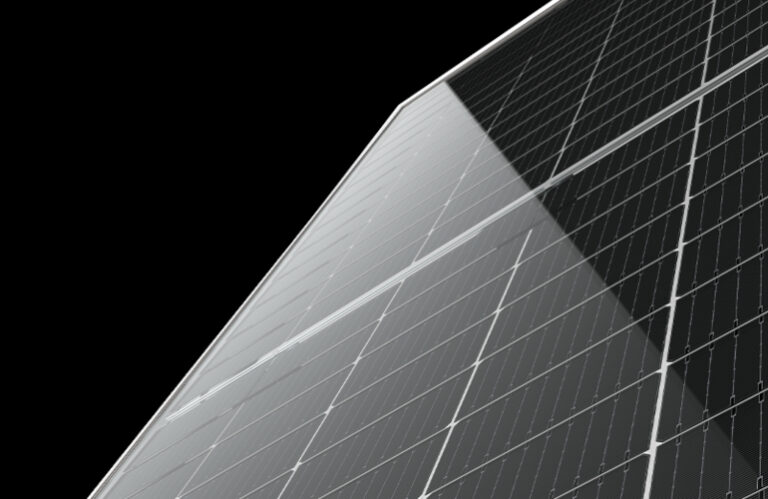In the ongoing race to do more with less, solar panels in the utility space have become increasingly powerful, as well as larger, heavier and bulkier. To reduce the cost and weight of the two largest components on a bifacial module, manufacturers have reduced each piece of glass to a thickness of 2mm. But a new problem soon arose on two-sided projects in the central United States: These panels with thinner glass suffered more damage than panels with backing plates during the region’s usual hailstorms. Maybe cheaper, lighter glass wasn’t the right choice.
Solar panel manufacturers discovered that the simplest and frankly most obvious thing was to go back to the traditional 3.2mm glass thickness. JinkoSolar recognized the hail problem in 2021 and released the bifacial module made of thicker glass EAGLE G5b to the North American market.

Illustration of the Jinko module
“There was a mass migration to double glazing products, mainly to reduce costs, and the glass became increasingly thinner. We were concerned about hail exposure and thinning of the glass,” said Adam Detrick, US director of product management and technical services for JinkoSolar US. “We decided to differentiate ourselves and keep an eye on hail, so we opted for a 3.2mm glass, transparent back panel.”
However, just using a thicker piece of glass is not the full story. Companies like Jinko, Trina Solar and LONGi use tempered glass instead of heat-resistant glass on their hail-resistant brands. Tempered glass is five times stronger than heat-resistant glass, says Brenden Frazier, product manager at Trina Solar US.
“Because the front glass is thicker, the tempering process can be carried out more easily,” he said. “A lot of typical 2mm glass is heat strengthened, and there is a fair amount of strengthening when you put it through that heat process, but it’s not nearly as strong as fully tempered glass.”
Trina has developed a hail-resistant version of it Vertex N bifacial module shipping in Q2 2025. In addition to tempered glass, the module has a transparent back plate. Backsheet quality was questionable a decade ago, another reason why brands switched to double-glazed designs, but things have improved, especially with transparent backsheets.
“A few years ago we pointed out that a backsheet module was a problem,” Frazier said. “But we’ve done a lot of work in that area, a lot of work with our TOPCon reliability and extensive backsheet reliability testing. We are putting this hail-resistant module through full testing and have full confidence in the performance and reliability of the backsheet.”
The first to really explore hail-resistant designs, Jinko collaborated with DuPont on a Tedlar-based transparent backplate that has proven itself on Jinko projects over the past three years. Detrick said that with the 3.2mm glass, transparent back design catching on with other brands promoting hail-resistant modules, Jinko is once again pushing the boundaries, this time back to double-glazed models.
“When we looked at deploying our TOPCon product in the United States, we looked at how we could do this even better,” he said. “Our new one G6Xintroduced in 2024, is a double-glazed version of the hail-resistant product. It’s not just about the glass thickness; There are several elements that fit into a hail-resistant module. Construction and materials are important. We have a recipe of what we think works best with a double glass format. We called it EAGLE Talon Glass, and that’s what we put on the G6X product.”
Jinko won’t reveal the features of its patented glass technology, but modules with EAGLE Talon Glass have been tested by Kiwa PVEL and RETC and have received top and high performer ratings. While the IEC test standard requires solar panels to withstand 25mm hailstones at a speed of 23m/s, Jinko’s EAGLE G6X line can withstand 55mm hailstones at the same speed – larger than a standard golf ball. With the likelihood of frequent golf ball-sized hailstorms increasing due to climate change, Jinko’s double-glazed hail-resistant panels should perform well in the United States.
“We’ve learned that the best solution isn’t necessarily completely intuitive,” Detrick said. “Everyone talks about thicker glass being better, and we keep coming back to the fact that it’s not the only thing, there are other factors to consider as well.”
Although the details of Jinko’s new module design have not been published, you can compare datasheets. Jinko’s 2mm, heat-strengthened, double-glazed module has a height of 30mm and weighs 68 lb. The 3.2mm hardened clear backplate module is 35mm and 61 lb. The new dual glass module using EAGLE Talon Glass is back to 30mm but weighs 83 lb.
Jinko’s new design shows that not all solar panels can be easily installed solo, but also that not all solar panels have to be hail-resistant. Hail isn’t a problem everywhere in the United States, so solar projects in Nevada, for example, don’t have to have the heaviest and strongest panels. That’s why all the brands that make hail-resistant modules still make the heat-strengthened 2mm double-glazed designs, along with 3.2mm alternatives.
“We don’t want to look at our hail-resistant modules myopically, like, ‘Here’s a bill of materials that’s great for hail.’ It also has to do these other things,” Detrick said. “With its heavier, thicker construction, the EAGLE G6X has much higher wind resistance than standard modules, so we are advertising it globally as a complete solution for extreme weather.”


